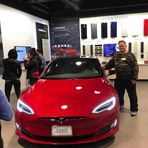The Ripple Effect of Trump's Auto Tariffs: A New Era for the Automotive Industry
April 4, 2025, 3:42 am

Location: Netherlands, North Holland, Hoofddorp
Employees: 10001+
Founded date: 2021
Total raised: $331.53M

Location: United States, Texas, Austin
Employees: 10001+
Founded date: 2003
Total raised: $3.86B

Location: United States, California, Torrance
Employees: 10001+
Founded date: 1959
The automotive landscape is shifting. President Trump's 25% tariffs on imported vehicles have sent shockwaves through the industry. The tariffs, which took effect recently, are not just numbers on a spreadsheet; they represent a seismic shift in how cars are made, sold, and perceived in the U.S. market.
As the dust settles, the immediate impacts are becoming clear. Automakers are scrambling to adapt. Some are idling plants, while others are slashing prices to entice buyers before the full brunt of the tariffs hits. The stakes are high, and the consequences could reshape the industry for years to come.
The tariffs target vehicles not assembled in the U.S., affecting nearly half of the cars sold domestically. This means that many popular models, including entry-level vehicles, are now facing steep price increases. The average cost of a new vehicle, currently around $48,000, could rise by as much as $10,000. This is a bitter pill for consumers, especially those looking for affordable options.
Automakers are caught in a bind. They need to maintain sales while grappling with rising costs. Ford, for instance, has rolled out discounts across its lineup, reminiscent of past promotions aimed at boosting sales during economic downturns. Meanwhile, companies like Stellantis are halting production in Canada and Mexico, a move that reflects the uncertainty looming over the industry.
The tariffs are part of a broader trade war that has already strained relationships with key trading partners. Canada has announced retaliatory tariffs on U.S.-made vehicles, further complicating the landscape. The automotive sector is now a battleground, with companies forced to navigate a maze of tariffs, price hikes, and shifting consumer behavior.
Analysts are sounding alarms. The potential for a recession in the automotive sector looms large. Many fear that the tariffs could decimate earnings and lead to significant job losses. General Motors, for example, faces a staggering 79% drop in earnings before interest and taxes due to the tariffs. This is not just a number; it represents real people and communities that depend on the automotive industry for their livelihoods.
The impact of the tariffs extends beyond the immediate financials. The global supply chain is in turmoil. Automakers rely on a complex web of parts sourced from around the world. Even vehicles assembled in the U.S. contain a significant percentage of imported components. This interconnectedness means that no automaker is immune to the effects of the tariffs.
For companies like Tesla, the situation is different. With all its vehicles assembled in the U.S., Tesla is positioned to weather the storm better than its competitors. Analysts see it as a structural winner in this new landscape. However, for traditional automakers, the tariffs represent a margin reset and a real drag on near-term earnings.
As consumers rush to dealerships to lock in prices before the tariffs take full effect, the automotive market is experiencing a temporary surge. Sales in March hit an annual rate of 17.8 million vehicles, the highest since April 2021. But this rush may be short-lived. Once the supply runs out, the reality of higher prices will set in, and sales could plummet.
The long-term effects of the tariffs are still uncertain. Automakers are lobbying for exemptions on certain low-cost components, but the outcome remains unclear. The industry's ability to adapt will be tested in the coming months. Will they pivot quickly enough to avoid a downturn? Or will the tariffs prove to be a fatal blow for some?
In the face of these challenges, automakers are exploring new strategies. Some are considering relocating production to the U.S. to mitigate the impact of tariffs. However, this is not a quick fix. Building new plants and reconfiguring supply chains takes time and investment. The clock is ticking, and the pressure is mounting.
The automotive industry is at a crossroads. The tariffs have forced a reevaluation of how cars are made and sold. The days of relying heavily on imports may be numbered. As companies scramble to adapt, the landscape will continue to evolve.
In this new era, the question remains: who will emerge as the victor? The answer is still unfolding. For now, the automotive industry is in a state of flux, grappling with the immediate fallout of tariffs that could reshape its future. The road ahead is uncertain, but one thing is clear: the impact of these tariffs will be felt for years to come.
As the industry navigates this turbulent terrain, consumers, investors, and automakers alike will be watching closely. The stakes are high, and the outcome will determine the future of the automotive landscape in America. The ripple effect of these tariffs is just beginning, and its full impact remains to be seen.
As the dust settles, the immediate impacts are becoming clear. Automakers are scrambling to adapt. Some are idling plants, while others are slashing prices to entice buyers before the full brunt of the tariffs hits. The stakes are high, and the consequences could reshape the industry for years to come.
The tariffs target vehicles not assembled in the U.S., affecting nearly half of the cars sold domestically. This means that many popular models, including entry-level vehicles, are now facing steep price increases. The average cost of a new vehicle, currently around $48,000, could rise by as much as $10,000. This is a bitter pill for consumers, especially those looking for affordable options.
Automakers are caught in a bind. They need to maintain sales while grappling with rising costs. Ford, for instance, has rolled out discounts across its lineup, reminiscent of past promotions aimed at boosting sales during economic downturns. Meanwhile, companies like Stellantis are halting production in Canada and Mexico, a move that reflects the uncertainty looming over the industry.
The tariffs are part of a broader trade war that has already strained relationships with key trading partners. Canada has announced retaliatory tariffs on U.S.-made vehicles, further complicating the landscape. The automotive sector is now a battleground, with companies forced to navigate a maze of tariffs, price hikes, and shifting consumer behavior.
Analysts are sounding alarms. The potential for a recession in the automotive sector looms large. Many fear that the tariffs could decimate earnings and lead to significant job losses. General Motors, for example, faces a staggering 79% drop in earnings before interest and taxes due to the tariffs. This is not just a number; it represents real people and communities that depend on the automotive industry for their livelihoods.
The impact of the tariffs extends beyond the immediate financials. The global supply chain is in turmoil. Automakers rely on a complex web of parts sourced from around the world. Even vehicles assembled in the U.S. contain a significant percentage of imported components. This interconnectedness means that no automaker is immune to the effects of the tariffs.
For companies like Tesla, the situation is different. With all its vehicles assembled in the U.S., Tesla is positioned to weather the storm better than its competitors. Analysts see it as a structural winner in this new landscape. However, for traditional automakers, the tariffs represent a margin reset and a real drag on near-term earnings.
As consumers rush to dealerships to lock in prices before the tariffs take full effect, the automotive market is experiencing a temporary surge. Sales in March hit an annual rate of 17.8 million vehicles, the highest since April 2021. But this rush may be short-lived. Once the supply runs out, the reality of higher prices will set in, and sales could plummet.
The long-term effects of the tariffs are still uncertain. Automakers are lobbying for exemptions on certain low-cost components, but the outcome remains unclear. The industry's ability to adapt will be tested in the coming months. Will they pivot quickly enough to avoid a downturn? Or will the tariffs prove to be a fatal blow for some?
In the face of these challenges, automakers are exploring new strategies. Some are considering relocating production to the U.S. to mitigate the impact of tariffs. However, this is not a quick fix. Building new plants and reconfiguring supply chains takes time and investment. The clock is ticking, and the pressure is mounting.
The automotive industry is at a crossroads. The tariffs have forced a reevaluation of how cars are made and sold. The days of relying heavily on imports may be numbered. As companies scramble to adapt, the landscape will continue to evolve.
In this new era, the question remains: who will emerge as the victor? The answer is still unfolding. For now, the automotive industry is in a state of flux, grappling with the immediate fallout of tariffs that could reshape its future. The road ahead is uncertain, but one thing is clear: the impact of these tariffs will be felt for years to come.
As the industry navigates this turbulent terrain, consumers, investors, and automakers alike will be watching closely. The stakes are high, and the outcome will determine the future of the automotive landscape in America. The ripple effect of these tariffs is just beginning, and its full impact remains to be seen.
